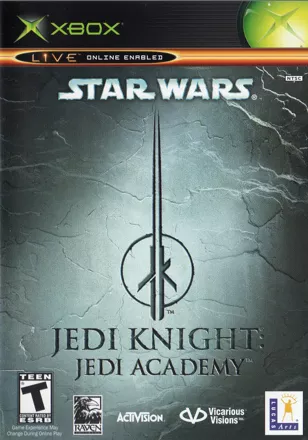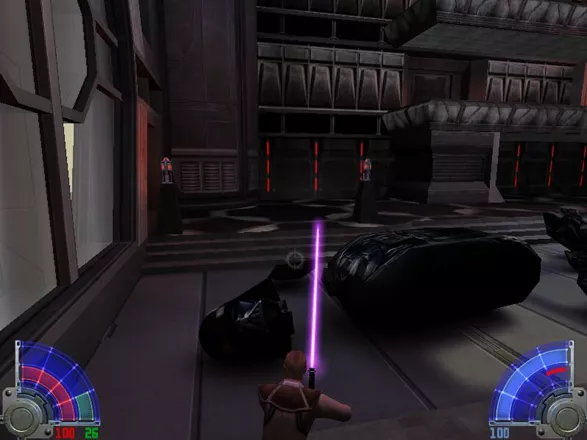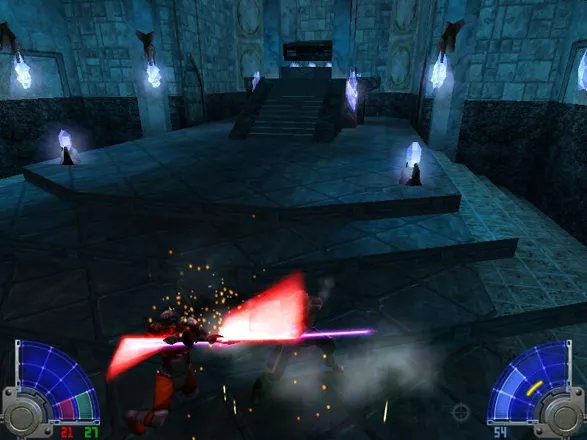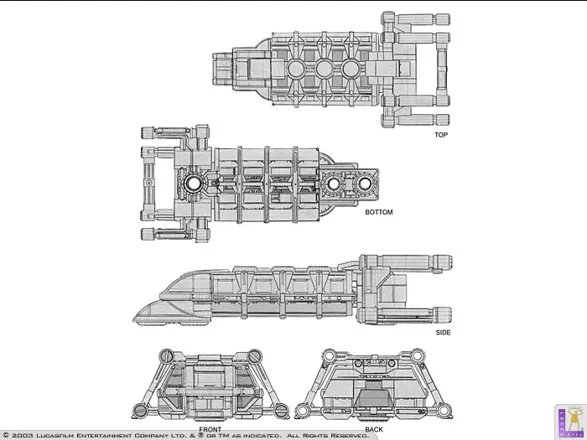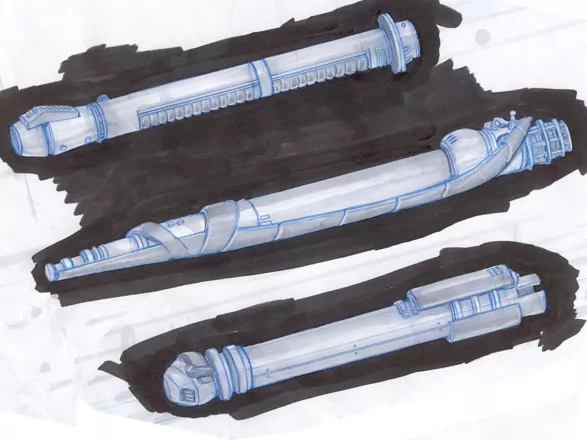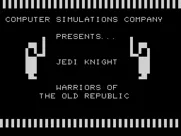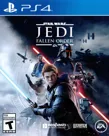Star Wars: Jedi Knight - Jedi Academy
Description official descriptions
Star Wars: Jedi Knight - Jedi Academy is the sequel to Star Wars: Jedi Knight II - Jedi Outcast. The player is cast as Jaden Korr, a padawan at the Jedi Academy taught by Luke Skywalker and Kyle Katarn. Both the character and his lightsaber are to be created at the beginning of the game. Throughout the game, the player will acquire several force powers and weapons, such as lightning and the Tenlos Disruptor Rifle. As he progresses through the different missions, he may be seduced by the dark side of the Force...
Spellings
- スター・ウォーズ ジェダイナイト:ジェダイアカデミー - Japanese spelling
- 杰迪武士:杰迪学院 - Simplified Chinese spelling
Groups +
- 3D Engine: id Tech 3 (Quake III: Arena)
- Console Generation Exclusives: Xbox
- Force Powers-themed games
- Games with official modding tools
- Games with officially released source code
- Middleware: Bink Video
- Protagonist: Female (option)
- Protagonist: Visually customizable character
- Setting: Space station / Spaceship
- Standalone expansions
- Star Wars licensees
- Star Wars: Dark Forces / Jedi Knight series
- Xbox World Collection series
Screenshots
Promos
Videos
See any errors or missing info for this game?
You can submit a correction, contribute trivia, add to a game group, add a related site or alternate title.
Credits (Windows version)
207 People (185 developers, 22 thanks) · View all
| Project Leads | |
| Lead Designer | |
| Designers | |
| Lead Artist | |
| Artists | |
| Additional Art | |
| Lead Animator | |
| Animators | |
| Lead Programmer | |
| Programmers | |
| [ full credits ] | |
Reviews
Critics
Average score: 77% (based on 54 ratings)
Players
Average score: 3.7 out of 5 (based on 88 ratings with 10 reviews)
More of the Same, and why that's good and bad.
The Good
It’s been ten years since the defeat of the Empire above Endor’s sanctuary moon. While the New Republic continues to battle the Imperial Remnant, Luke Skywalker’s newly trained Jedi are fulfilling their historical role—that of guardian and peacekeeper. This may not be a dark time for the Republic, but it is a tenuous time for the Jedi, especially with the Cult of Ragnos threatening to resurrect the ancient Sith lord.
The Cult reveals itself during the opening cutscene, firing on a transport carrying would-be students. This is revealed to be a diversionary tactic, with the Cult’s real motive involving hacking into the Academy’s computers. If the Cult can locate areas strong with the Force then they can siphon the Force energy for their Master. At this point in the Dark Forces franchise, you’d think that only Kyle Katarn could thwart their dastardly deeds. You’d be wrong.
After the events of Jedi Outcast, Katarn is now a Jedi Master training students (of which Jaden, your character, is one). In an interesting contrast to the RPG Knights of the Old Republic, Jedi Academy begins with you picking Jaden’s gender and race (KotOR offered human-only role playing). You then customize Jaden’s outfit and select a lightsaber color and hilt. As you progress through the game you also add new Force Powers, so in many ways Jedi Academy blurs the line between shooter and RPG.
While the entire game covers the Cult of Ragnos threat, the structure of Jedi Academy differs from previous entries. After the initial events and training/tutorial levels, you are presented with five missions around the galaxy. You can play the missions in any order and only have to complete four of them to advance to the next tier. The structure of the game works out to be five mini-missions followed by one larger story-related mission, repeated three times.
As you move up in tiers, your core Force powers (Jump, Speed, Push, etc) advance to the next level (up to level three- Jedi Knight). After each mission, you can add a new Force power or strengthen a preexisting one. These are the other Force powers (Light or Dark Side) like Heal, Grip, Mind Trick, etc. In an interesting switch, Force powers no longer seem to be viewed as good or evil, rather it’s how you use them.
Unlike Jedi Outcast, you start off with a lightsaber (something Jaden was able to build on his own before the Academy). Lightsaber combat is even more dynamic this time around with many more new moves and combinations. I can’t really say I figured out how to use the new moves, but with frantic button mashing I executed many of them. Towards the end of the game, you have the option of keeping with your single saber or picking dual sabers or a double-ended saber. You can also bring along the clumsy, random blaster and other weaponry if you want to try Jedi Academy as a FPS. These weapons are less vital this time around, especially against Dark Jedi who can deflect blaster bolts and Force Push missiles back in your direction.
So how is the game? The mini-missions are a lot of fun. There are plenty of different landscapes, mission types, villains, etc. You can investigate an attack on a Jawa Sandcrawler, become the hunted in a The Most Dangerous Game level, explore the acid rain blasted ruins of Vader’s Bast Castle, plant targets on an orbital platform for a Rogue Squadron assault, and more. Within the missions you can ride Tauntauns on Hoth, race along on swoop bikes, turn a capital ship’s turrets against a wave of TIE Fighters, and kill many many Stormtroopers and Dark Jedi.
The Bad
So what’s wrong with this game?
First off, this is the first Dark Forces game which isn’t a great improvement over its predecessor. In-game graphics are great and the rendered cutscenes look great, but the cutscenes using the game’s engine are poor. Lip-synching is way off and character animation is clumsy. Pathfinding seems to be missing in missions where characters fight along side you and they are also less effective this time around and more prone to falling down chasms, not reacting to combat situations, and (in one strange situation) attacking each other. Finally, spawning is very visible in this game—it’s very disconcerting to see enemies beam in right in front of you.
Then, while the mini-missions are varied, there is no depth to them so you have a nonlinear game comprised of very linear missions. One mission was so strictly scripted that I had to restart the mission when I took the wrong path. Other missions end abruptly once the goals have been met, so in some cases it may be possible to escape combat and just run from objective to objective.
Finally, the story is serviceable but lacks the punch of Dark Forces, the scope of Jedi Knight, or the richness of Jedi Outcast. Jedi Academy does feature a Light and Dark Side path, near the very end of the game. Unlike Jedi Knight, which had a primitive, but workable, alignment system, Jedi Academy stops the game at a crucial moment and tells the player: “Do this to be on the Light Side or do this to be on the Dark Side.” The end result is something that feels like a compilation of mod missions, feebly tied together.
The Bottom Line
Where does this leave us?
Jedi Academy is still a great game, but it suffers in comparison to Jedi Outcast. I would recommend this game for its fun, short missions that mix familiar worlds and characters with new planets and enemies. I think it misses the mark set previously, but it was such a high mark.
Windows · by Terrence Bosky (5397) · 2004
A less than perfect romp through the Star Wars universe tied together with a sham of a story
The Good
This game capitalizes on its predecessor's strength: lightsaber combat. This time around there is more variety with plenty of opponents and new saber modes (dual saber and saber staff). While these fights can get fairly hectic, the developers have added some special moves that you can execute, and the whole experience can really come together quite well.
While the story is minimal, and there is a groan factor at the beginning of every mission as you "unexpectedly" encounter trouble in the unlikeliest of places, once the action gets going it is generally varied enough to keep you entertained. There are vehicles to operate, huge monsters to contend with, and you even get to man the battle stations to shoot down some TIE ships a couple of times.
The Bad
The games missions are structured more like "chores", which you must do in groups of five (you can skip one of each group), in order to get the the few plot-advancing missions. This means that each one is mostly unrelated to the others plot-wise. A major gripe I have with these missions is a good 50% of them are not what they advertise to be. For example there is an early mission taking you with rescuing crash survivors. However once you get to the crash site, your ship breaks and it turns out there are no survivors to save. So the mission is actually about fixing your ship to get back. There are quite a few such bait-and-switches, where nothing gets accomplished by your being there.
My second biggest gripe is the level design. Of all the Jedi Knight games, I believe the first one with its old proprietary engine worked the best at presenting Star Wars' massive settings. In Jedi Academy, to an even greater extent than in Outcast most of the levels seem cramped and artificially walled off. Additionally, some of the levels' population of baddies goes strangely unexplained. While it's easy to believe that an Imperial Remnant installation on some god-forsaken planet would be full of Storm Troopers, one tends to wonder why the rooftops of a residential district on Corusant are a veritable menagerie of alien life hell-bent on trying to kill you. Civilians are nowhere to be seen, even in places you would expect them, and a number of areas seem empty and desolate because of this. And while there is significant variety in levels, a lot of them are simply a sequence of nondescript hi-tech looking rooms with various meaningless displays, populated by a lot of troopers. I believe that the use of the Quake 3 engine, which was designed to allow for intense combat in relatively small and cramped quarters really hurts the game here.
Puzzles are more or less meaningless - there are buttons to push and keys to find, but it seems like they're only there because one is supposed to be pushing buttons and finding keys in these types of games. The rule of thumb is push any button you see, and this will get you past 90% of the games "obstacles".
It is also unfortunate that the designers chose to limit the use of force powers to a few "key" points. For example, while you posses the push and pull force powers, you can only use them on designated objects in the game world. It would be much more fun to incorporate the force powers into the physics system, and allow the player to find creative ways to use them to navigate obstacles. Instead you will see your trigger light up when pointed at a "force-friendly" object, to let you know that this rock, out of thousands of identical rocks in the level can be force-pushed.
The Bottom Line
Despite its flaws, it is definitely an enjoyable experience once you get going. The lightsaber fights alone are worth the price for a star wars fan. As a shooter/saber fighter it's a pretty good game, but don't expect a lot of Star Wars immersion.
Windows · by Lev Epshteyn (10) · 2003
The new lightsabers don't make up for the terrible plot, cutscenes and voice acting.
The Good
Since it uses the same engine as Jedi Knight 2, you know what to expect from this game graphics-wise. This is a good or bad thing, I suppose. Certainly the graphics are dated, but hell, they RUN on my computer, so that's a good thing in my book.
New lightsabers! If there's one thing to sell this game, it's the new lightsaber tricks, which are certainly cool. Two lightsabers, a saberstaff, new special moves, combined with force powers and slow-motion "finishing moves" -- it makes for some memorable battles, and more than once I quick-loaded back just to replay a fight, even if I beat it flawlessly the first time.
The hoverbike levels were actually pretty awesome.
The Bad
Unfortunately, "two new lightsabers" is about all this game has going for it. Everything else is abysmal. Don't even mention the plot in this game, because it's about the worst I've seen in any computer game in recent memory.
The first disappointment I found was that, unlike every previous Dark Forces game, you're not playing Kyle Katarn. Instead, you're some student in a Jedi Acadamy who quickly (VERY quickly) rises to the title of Jedi through fight after fight after fight. The fights are cool, don't get me wrong...but it doesn't make any sense toward the plot.
You're given five missions, and then a plot mission. Rinse. Repeat. And with every of those five missions, your task involves something like, "Go talk to this guy," only, in every case, you'll not only NOT "talk to this guy", but you'll find that you were -- gasp -- ambushed by a hundred lightsaber-wielding goons.
At the end you get a choice between choosing the light path or the dark path, but the outcome is pretty much the same. At least, it was for me. If you choose the light path, you fight alongside other studen jedis -- unless the morons get in the way of your lightsaber and you accidentally cut one up, in which they all turn against you. And heck, that's even funner. That's essentially the dark path, as well. Same level, same thing, only you fight other jedis as well as bad guys.
The cutscenes are awful. Animation is awkward and just plain bad. And the voice acting certainly doesn't make up for it. Especially annoying is the voice of a fellow student who turns on you, which is also pretty obvious from the first time you meet him.
Your character has absolutely no depth to him at all. You know nothing of his past, you know not why he's becoming a jedi, you don't know anything. And you don't need to, I guess, because your task is just to go in and kill everything and beat the game. Don't expect anything from this game other than an arcade hack 'n slash, because that's all it amounts to.
Also what I found disappointing was that you start with a lightsaber. I loved how in Jedi Knight 2, the first half of the game you are without it. It was like playing two games -- a Star Wars first-person shooter, and then a lightsaber-swingin' third-person hack 'n slash. Unlike many people, I didn't mind the first half at all. In fact, I may have enjoyed it more than the second. But Jedi knight 2 was an awesome game. Jedi Acadamy is NOT.
The Bottom Line
It's Jedi knight 2 without the cream in the middle. It's shiny on the outside but completely hollow within. The new lightsaber stuff almost makes up for it, as long as you're not expecting anything more than what it delivers.
Windows · by kbmb (415) · 2003
Trivia
Manual error (pg 30): the DL-44 Heavy Blaster Pistol (the default blaster) does have an ammo type: the Blaster Pack and the alternate attack (charging the blaster for a powerful shot) does work in the single player game.
Analytics
Upgrade to MobyPro to view research rankings!
Related Sites +
-
Clan Mod
A Jedi Knight: Jedi Academy Multiplayer Modification. On these forums you can chat with developers of different mods who are helping to compile this mod. -
Graduate Summa Cum Lightsaber
An Apple Games article about the Macintosh version of Jedi Academy, with commentary being provided by Producer Brett Tosti (December, 2003).
Identifiers +
Contribute
Are you familiar with this game? Help document and preserve this entry in video game history! If your contribution is approved, you will earn points and be credited as a contributor.
Contributors to this Entry
Game added by James Kirk.
Macintosh added by Corn Popper. Nintendo Switch added by Rik Hideto. Xbox One added by Kennyannydenny. Xbox added by Kabushi. PlayStation 4 added by MAT.
Additional contributors: Terrence Bosky, Unicorn Lynx, Jacob Fliss, Zeppin, Rik Hideto.
Game added September 21, 2003. Last modified February 13, 2024.
